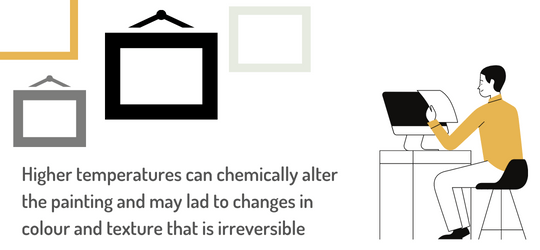
Whether you’re a serious collector, or you’re just getting started with your art collection – knowing how to store art can be the difference between an appreciating asset, and a ticking time bomb.
Conventional storage solutions like glad-wrap or bubble wrap aren’t the storage fix-all’s that you may have in mind. Traditional storage methods can (in fact) lead to mould and artwork degradation.
There are a lot of risks when it comes to storing art in your home. However, if you know what you are doing, you can smoothly navigate the process and even put together a makeshift art-gallery level environment in your home. In this article, we’ll outline faux pas’, provide actionable tips to store your art so that it can be enjoyed for years to come.

How to Prepare Your Art for Storage
When it comes to storing your art, there are a few things that you need to keep in mind to ensure that your art is well protected for storage:
- Ensure that your art is clean and free of art before storage. This will help to prevent any damage that could be caused by dirt or dust particles.
- Store your artwork in a dry, cool place. Avoid storing art in high-humidity environments that are subject to extreme temperature fluctuations.
- Use archival-quality storage materials, such as acid-free paper or boxes that help to protect your artwork from damage.
- Clearly label your storage containers so that you can easily find and unpack your art as required.
- Periodically check your artwork to ensure that it is still in good condition. If you notice any signs of damage, take steps to protect the artwork from further damage.
Precautions When Storing Canvas Paintings
When it comes to storing canvas paintings, there are a few extra precautions that you need to take to ensure that they are not damaged and do not deteriorate while they are in storage. And we know a thing about art – as the art installation Melbourne experts.
- Ensure that the painting is dry before storing. Residual moisture on the canvas from the move or from being displayed in a slightly humid environment prior to storage can have a damaging impact on your painting.
- Store in a temperature-controlled environment. Canvas paintings exposed to heat or humidity can warp or discolour.
- Keep canvas paintings out of direct sunlight. This one goes for storage & for display – when you display or store your canvas artwork, it needs to be in a cool, dark, and dry space.
Storing canvas artwork is a lot like storing wine. Avoid direct sunlight and temperature fluctuations for the best end result.
Maintaining the Perfect Art Storage Environment
When it comes to storing artwork – the number one element that you want to strive for is consistency. Art needs to be kept in a temperature-controlled environment that is not prone to sudden fluctuations to temperature or humidity.
Art galleries and museums are set up by professions whose job it is to create the perfect environment for art. Our wall hanging services Sydney team have experience in working with galleries and museums – Museums keep a temperature-controlled environment of 21 degrees Celsius (70 degrees Fahrenheit) and 55 percent relative humidity. These temperature and humidity levels form the ideal guide for storing your artwork for maximum longevity.
Galleries have the benefit of carefully calculated air-conditioning, heating, and ventilation systems that keep things at a consistent temperature all year around. If you don’t have this luxury, then finding a cool, dark room in your house like an attic or basement could be the best compromise. Set up a thermometer and humidity reader and periodically check on the room to ensure that a consistent temperature is maintained.

Should I Use Mirror Boxes for Storing Art?
Mirror boxes are a contentious issue in the art community, but for many they are a tried-and-true method to store art when putting your artwork into store. Some of the reasons that people swear by mirrored boxes include:
- Mirrored boxes protect from damage
- They can keep your art dirt and dust free
- Mirror boxes make it easy to find the piece of art you’re looking for
- They are cost effective
If you’re looking to put your collection into storage, it is certainly worth looking at mirrored boxes.
Wrapping Up
There are many ways that you can store and protect your art to ensure longevity. Use the tips outlined in this article to find the best solution based on the climate that you live, the space that you have available, and the type of art you are looking to store. As with most things, there is no one-size fits all solution, it’s about utilising the space and the resources that you have available to you.
